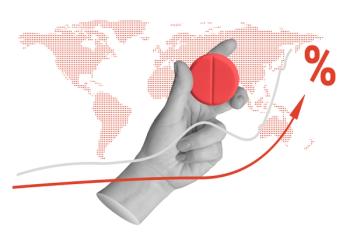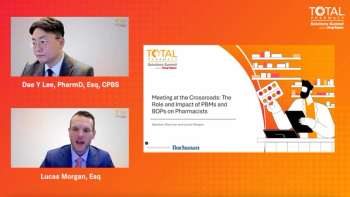
The Push Is on for Generics and Biosimilars
Stalled competition hurts consumers and may keep prices higher.
While generic and biosimilar drugs save the U.S. healthcare system millions of dollars a year, drug store chains and others say much more needs to be done to improve access and keep their costs low.
“Despite our efforts to lower costs for consumers, we are working within a system where competition has been stalled, which hurts the consumer most. We believe increasing market competition by making more generics available is absolutely necessary to make a real impact,” says CVS Health in a letter to HHS Secretary Alex M. Azar II.
The letter to Azar was in response to a Request for Information from the Trump Administration’s Blueprint to Lower Drug Costs.
In 2017, generic drugs generated $265 billion in savings, according to the annual Association for Accessible Medicine (AAM)
In addition, 93% of generic prescriptions are filled at $20 or less, and the average copay for a generic drug is $6.06, AAM finds.
“Small molecule generics will have a larger and nearer term impact on patient cost savings as their price discounts are generally larger and uptake/switching has been greater. From another perspective, the biosimilar savings are more important because they might not have happened at all, so the savings are all new,” Michael Kleinrock, research director at IQVIA, tells Drug Topics.
CVS kept drug price growth to 0.2% in 2017 despite manufacturer brand list prices increases on drugs of near 10%, the company states in the letter to Azar. “Further, over 30% of our clients spent less per member in 2017 than they did in 2016 on prescription drug costs.”
Similarly, Express Scripts says the widespread use of generic drugs helped it achieve a record-low drug price growth of 1.5% in 2017.
“By prohibiting pay-for-delay agreements, the U.S. government can curb anticompetitive practices and help bring lower cost, clinically-equivalent generic medications to market more quickly,” CVS Health says.
AAM says in its report, “Competition from generic drugs brings down drug prices. Yet every year we see increasing anticompetitive activity by brand drug companies to obstruct generic competition and thereby extend marketing monopoly for their high-priced brand drugs.” This activity includes manipulating FDA safety programs to block generic drug development, renting sovereign immunity to circumvent patent laws, and filing sham citizen petitions to derail generic approvals, it said.
Increasing the use of generic drugs is one of the most effective ways to reduce prescription costs, according to
NACDS supports closing loopholes to boost generic-medication access and lower costs, such as ending misuse of the risk evaluation and mitigation strategies program, which requires manufacturers to ensure the benefits of a drug or biological product outweigh its risks.
“Certain companies are employing restricted distribution networks to deny manufacturers of generics and biosimilars access to product samples they need to compete,” NACDS says in the letter. An analysis by Matrix Global Advisors found that this practice costs the healthcare system $5.4 billion annually, including $1.8 billion to the federal government.
Express Scripts, in an update on biosimilars and generics says: “This measure would address these anticompetitive practices by closing the loophole in the law and creating a clear pathway for generic and biosimilar manufacturers to access the sample products needed to bring lower-cost drugs onto the market.”
The increased generic and biosimilar competition provided by the
Solutions to Boost Biosimilar Cost Savings
“A fair playing field is not just about generics. We must expand the use of biosimilars and eliminate the tactics that stall competition,” CVS Health says.
To increase the availability of biosimilars, CVS Health believes the FDA should support shortening the exclusivity period for biologics from 12 to 7 years.
Express Scripts “strongly supports” requiring biosimilar manufacturers to provide the same rebates in the Medicare Part D doughnut hole paid by brand manufacturers, “a policy which will ensure patient access to these lower-cost alternatives,” the PBM says. “We were pleased to see this important change enacted into law as part of the enacted February 2018 congressional budget legislation. We encourage lawmakers to preserve this important patient protection.”
In addition, biologic and biosimilar manufacturers should report patent litigation lawsuits to the Federal Trade Commission and the Department of Justice. “Requiring these patent litigation settlements to be reported to FTC and DOJ will ensure that the agencies have the information needed to challenge anticompetitive agreements in federal court,” Express Scripts says.
NACDS supports policies “that promote confidence in and encourage increased use of more cost-effective biosimilar medications,” the organization said in its letter. To that end, FDA should adopt naming policies for biosimilar drugs and biologics that are consistent with the naming conventions for brand and generic small molecule drugs, that is assigning the same individual nonproprietary name (INN) to a biosimilar drug product that is assigned to the reference biologic drug counterpart.
“Special naming policies for biosimilar drugs (and other biological drugs) that deviate from the traditional naming scheme can undermine prescriber and patient confidence in biosimilar products, thereby discouraging their use and jeopardizing the savings that could otherwise be achieved through increased use of more cost-effective biosimilar products,” NACDS says.
Meanwhile, the FDA recently released an action plan designed to advance polices that will make the process for developing biosimilars more efficient.
“By enabling a path for competition from biosimilars, we also give innovators an added incentive to invest in further research that’ll lead to the discovery of even better drugs that deliver additional benefits for patients,” says FDA Commissioner Scott Gottlieb, MD, in a statement.
Biologics represented 70% of the growth in drug spending from 2010 to 2015, Gottlieb says. In addition, while less than 2% of Americans use biologics, they represent 40% of total spending on prescription drugs, according to Gottlieb. “Our plan is aimed at promoting competition and affordability across the market for biologics and biosimilar products”
Newsletter
Pharmacy practice is always changing. Stay ahead of the curve with the Drug Topics newsletter and get the latest drug information, industry trends, and patient care tips.










































































































































































































